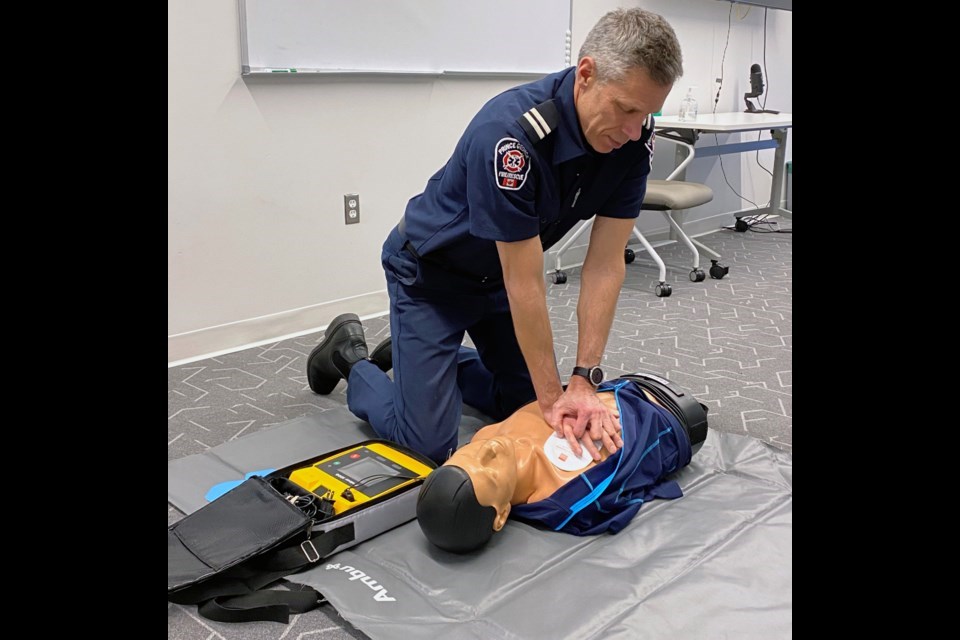The city’s public safety committee has received a report which outlines some of the details of what’s expected from Prince George Fire Rescue in regard to medical emergency responses at the pre-hospital stage.
On March 11, council directed administration to review the BCEHS agreement for time-critical calls and asked for a comparison to other city fire departments and the essential pre-hospital emergency health services they provide. Council wanted to ensure the City of Prince George is fairly and equitably reimbursed.
In 2022, PGFR firefighters responded to 8,931 calls between Jan. 1 and Nov. 30 that year and 5,385 (60 per cent) were medical callouts. Over the same 11-month period in 2023 there were 9,863 total calls, of which 6,127 (62 per cent) were medicals.
This year, from Jan. 1-Sept. 9, 4,692 (56.4 percent) of the 8,317 total callouts were for medical aid.
BC Emergency Health Services, the governing body that oversees the province’s pre-hospital care, in 2020 adopted a colour-coded clinical response model (CRM) to provide first responders an early assessment of the urgency of the patient’s condition, as determined in the 911 call.
The CMR uses six colours to designate the condition of the patient with purple (immediately life-threatening) and red (life-threatening or time-critical) ranked as the most urgent, orange (potentially serious but not immediately life-threatening) and yellow considered less urgent, and green and blue as the least urgent.
The BC Ambulance Service (BCAS) receives the call, provides triage to the 911 caller and categorizes the patient according to the CMR. If a patient is classed as a purple or red emergency, and in some cases orange, computer-aided dispatch software is configured to automatically send call data to the Prince George fire dispatch centre.
City staff determined it is not possible to provide council with cost estimates related to the different CMR tier levels due to limitations of the current system of reporting, tracking and determining inventory levels.
Costs and equipment used by PGFR depend on when the ambulance arrives or if the fire department’s response is cancelled while they are on their way to the call. If the fire department gets to the patient first, firefighters will provide the necessary medical aid up to their level of training as emergency medical responders. Once the paramedic arrives, the firefighter transfers treatment to BCAS and might assist with loading the patient into the ambulance.
If BCAS gets there first the firefighters might assist with patient treatment and loading or they might stand by while the paramedic conducts the assessment.
Fire Chief Cliff Warner looked at Vancouver and Surrey fire departments and both reported in the spring of 2022 there was a substantial increase in medical calls with half the front line firefighters tied up on medical aid incidents waiting for ambulance to arrive. To try to free up firefighters' time so they were more available to put out fires or respond to hazard incidents, the two fire departments reduced their responses to low-acuity orange incidents.
Warner also examined the Prince George and Delta fire departments and found that while both experienced higher medical call volumes and wait times for BCAS ambulances, there were very few times when firefighters from either city were tied up on medical calls to the point where it would result in delays to attend other emergency incidents.
“There were a couple of instances where the delays in ambulances resulted in us having to call staff in as a result of medical calls because of the length of the event,” said Warner. “When you look from a cost perspective, we’re staffed daily for all hazards. If we don’t go it doesn’t change anything in the cost from a staff perspective.”
In Prince George, about 50 per cent of medical calls resulted in fire crews assisting BCAS with patient treatment, 40 per cent arrived and left without requiring treatment/assistance and nine per cent were cancelled on route.
Based on the information in the report, staff recommend that PGFR maintain its current service levels and approach. While it makes no recommendations regarding the content of the fire department’s BCEHS agreement, the report recommends advocacy efforts should be made to help reduce the costs of delivering services, especially where there is provincial jurisdiction involved, such as mental health and addictions management.



